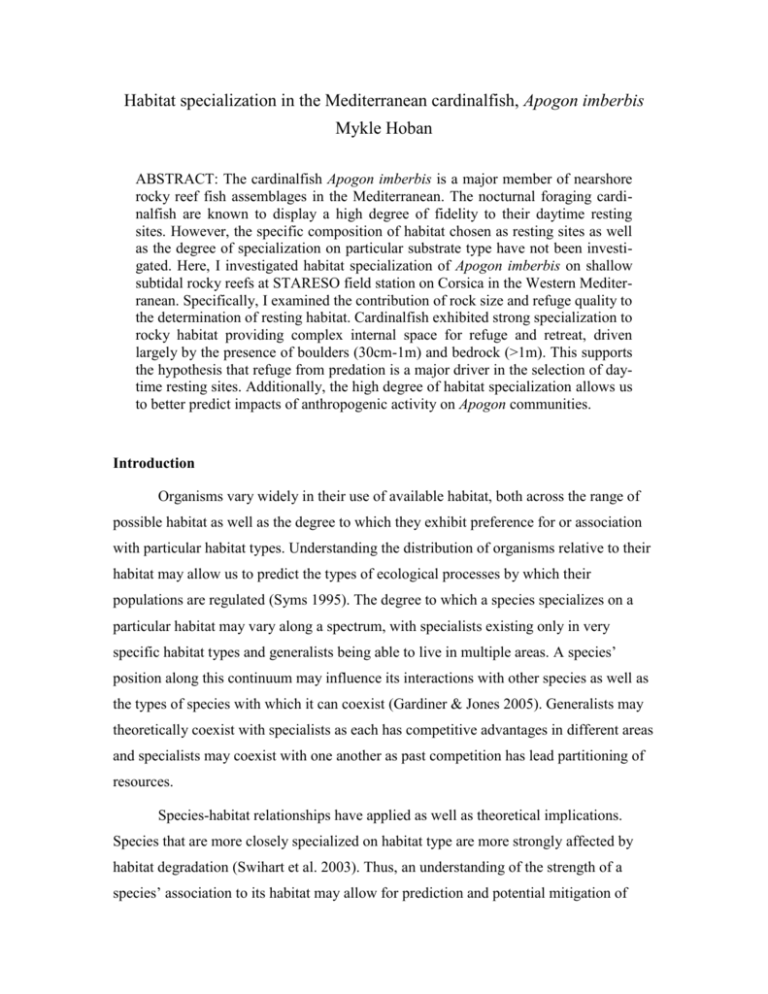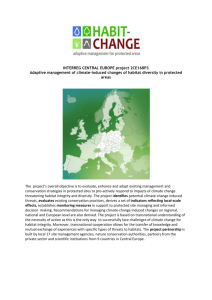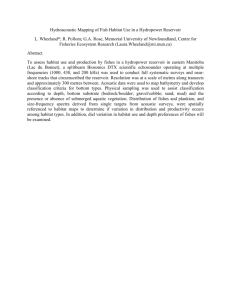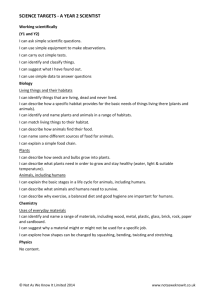Habitat specialization in the Mediterranean cardinalfish, Apogon
advertisement

Habitat specialization in the Mediterranean cardinalfish, Apogon imberbis Mykle Hoban ABSTRACT: The cardinalfish Apogon imberbis is a major member of nearshore rocky reef fish assemblages in the Mediterranean. The nocturnal foraging cardinalfish are known to display a high degree of fidelity to their daytime resting sites. However, the specific composition of habitat chosen as resting sites as well as the degree of specialization on particular substrate type have not been investigated. Here, I investigated habitat specialization of Apogon imberbis on shallow subtidal rocky reefs at STARESO field station on Corsica in the Western Mediterranean. Specifically, I examined the contribution of rock size and refuge quality to the determination of resting habitat. Cardinalfish exhibited strong specialization to rocky habitat providing complex internal space for refuge and retreat, driven largely by the presence of boulders (30cm-1m) and bedrock (>1m). This supports the hypothesis that refuge from predation is a major driver in the selection of daytime resting sites. Additionally, the high degree of habitat specialization allows us to better predict impacts of anthropogenic activity on Apogon communities. Introduction Organisms vary widely in their use of available habitat, both across the range of possible habitat as well as the degree to which they exhibit preference for or association with particular habitat types. Understanding the distribution of organisms relative to their habitat may allow us to predict the types of ecological processes by which their populations are regulated (Syms 1995). The degree to which a species specializes on a particular habitat may vary along a spectrum, with specialists existing only in very specific habitat types and generalists being able to live in multiple areas. A species’ position along this continuum may influence its interactions with other species as well as the types of species with which it can coexist (Gardiner & Jones 2005). Generalists may theoretically coexist with specialists as each has competitive advantages in different areas and specialists may coexist with one another as past competition has lead partitioning of resources. Species-habitat relationships have applied as well as theoretical implications. Species that are more closely specialized on habitat type are more strongly affected by habitat degradation (Swihart et al. 2003). Thus, an understanding of the strength of a species’ association to its habitat may allow for prediction and potential mitigation of community impact of anthropogenic influence (shoreline development, pollution, etc.). It is also important to understand habitat associations in the context of population assessment. Knowledge of the degree of specialization on a particular habitat type can contribute to better sampling protocol design for population estimates. Broad, random sampling for strongly associated organisms or highly targeted sampling for loosely associated organisms can produce skewed and inaccurate estimates. Proper assessment of species-habitat associations can make these estimates both more accurate and more efficient. Overall, understanding of habitat selectivity can provide valuable input to applied ecosystem-based management systems (Dissanayake & Stefansson 2012). The cardinalfish Apogon imberbis (Perciformes: Apogonidae) is a commonly occurring predatory fish associated with rocky reef habitat throughout the eastern Atlantic and Mediterranean. Apogon imberbis occupies crevices and caves during the day, emerging at night to forage on small fish and invertebrates across both hard and softbottomed areas (Azzurro et al. 2007, Bussotti et al. 2009). In tropical systems, apogonids have been shown to exhibit a high degree of fidelity to their daytime resting sites, returning from up to 2km distance after displacement, in addition to strong habitat specialization (often to individual coral species) (Marnane 2000, Gardiner & Jones 2005, Døving et al. 2006). Despite its position as the sole endemic cardinalfish species in the Mediterranean (it is the only species present at the study site), Apogon imberbis has received little attention regarding these features of its life history. Its diel movement (from refuge sites during the day to foraging sites at night), in combination with site fidelity and a high degree of habitat specialization, may provide a significant source of organic material movement onto rocky reefs and marine caves in the Mediterranean (Bussotti et al. 2009). Additionally, stable isotope studies have revealed A. imberbis, despite its small size, to be an important high trophic level feeder (Pinnegar & Polunin 2000) and an integral member of Mediterranean subtidal food webs. The goal of this study was to elucidate the degree of habitat specialization shown by Mediterranean cardinalfish. As cardinalfish are nocturnal feeders and daytime habitat use appears to be driven primarily by its suitability as a refuge or resting site, I examined habitat use in the context of its refuge quality. Specifically, to understand whether A. imberbis shows habitat selectivity based upon daytime refuge quality, I quantified overall available rocky-bottomed habitat as well as specific habitat in which cardinalfish were found. For both surveys, I assigned qualitative scores based on resting site or refuge suitability and then compared overall habitat and refuge availability to cardinalfish habitat and refuge use. Additionally, I noted cardinalfish habitat use (i.e. their position in the water) relative to available refuge. Methods Study System and Species I characterized cardinalfish habitat and distribution in subtidal communities adjacent to STARESO (Station de Recherches Sous-Marines et Oceanographique) field station near Calvi, Corsica (8°45'E, 42°35N, Figure 1). The nearshore marine environment consists largely of granitic substrate ranging from contiguous bedrock to small cobble fields. The bottom slopes to extensive beds of the seagrass Posidonia oceanica beginning at 4.5m-14m depth. Available hard-bottom space is primarily occupied by low-lying red and brown algal communities. The nocturnal cardinalfish, Apogon imberbis (Apogonidae) is found over rocky substrate throughout the Mediterranean and the eastern Atlantic coast (approx. Morocco to the Gulf of Guinea). Apogon imberbis forages at night and resides in or near rock crevices and caves during the day (Bussotti et al. 2009). Figure 1. Location of STARESO, Pte. Revellata, Corsica General Approach I surveyed cardinalfish assemblages and available habitat on scuba at depths between 2.5m and 13.5m along 50m transect lines to the north and south of the STARESO harbor. I conducted four surveys to the north and one to the south. Transect locations were determined by the presence of cardinalfish in these areas (Figure 2). Cardinalfish surveys were carried out during the day, to ascertain daytime resting habitat use. Figure 2. Location of 50m fish and habitat survey transects relative to STARESO harbor (not to scale) Cardinalfish abundance and habitat use To characterize habitat use by Apogon imberbis, I laid 50m transect lines parallel to shore, beginning in areas where fish assemblages were noticed. Divers counted total individuals 3m to either side of the transect. We placed 0.25m2 quadrats with 9 uniform points over sites occupied by fish and quantified habitat makeup based on rock size and substrate categories (0-5cm – “golf ball”, 5-10cm – “fist”, 10-30cm – “head”, 30cm-1m – “boulder”, >1m – “bedrock”, sand, Posidonia seagrass) as well as fish position relative to the available habitat (“inside” – within an enclosed space, “outside” – near, but not inside an enclosure, “water column” – positioned completely above the substrate). In addition to a quantitative measure of habitat composition, we assigned a qualitative score (1-4) to rate the area by suitability of refuge. Low scores (1-2) indicated relatively flat substrate without internal volume into which fish could escape. Higher scores (3-4) denoted more complex space for retreat and cover (Table 1). Table 1. Description of qualitative refuge scores Habitat availability I quantified available habitat by performing uniform (every 2.5m, =20 points) sampling along 50m transects through the areas where fish habitat use was surveyed. We placed 2.5m2 quadrats with 9 uniform points on either side of the transect line and quantified habitat and refuge quality using the methods outlined for habitat use. Do cardinalfish exhibit daytime habitat specialization? To test the hypothesis that cardinalfish occupy a specific subset of available habitat, I used performed a multivariate analysis of group similarities (ANOSIM) to compare composition of space occupied by fish and available habitat using the R package vegan (R Development Core Team 2011, Oksanen et al. 2012). I analyzed significant differences with vegan using similarity of percentages (SIMPER). Specifically, I determined the contribution of each substrate type/size to the dissimilarity between available and utilized habitat. For this and subsequent statistical analyses I chose a critical alpha value of 0.05. Do cardinalfish specialize their daytime habitat use based on refuge quality? To test the hypothesis that cardinalfish occupy daytime resting sites based upon the quality of refuge, I used a chi-square goodness-of-fit test to compare the distributions of fish and available habitat across the range of refuge scores. Do cardinalfish exhibit location preference relative to available refuge? To test the hypothesis that cardinalfish location with respect to the available habitat is non-random, I used a chi-square analysis to compare fish locations to an evenly distributed expected distribution. Results Overall Patterns The two most commonly available substrate types within the surveyed areas were boulder and bedrock (mean 16.1% and 57.9% cover, respectively). Cardinalfish habitat was also characterized largely by boulder and bedrock (mean 39.0% and 36.3% cover, respectively) (Figure 3). Figure 3. Mean proportion of substrate cover by survey type (fish habitat and available habitat) Do cardinalfish exhibit daytime habitat specialization? Substrate composition of habitat utilized by Apogon imberbis differed significantly from overall available habitat (ANOSIM, R=0.1082, p=0.001). Among substrate types, head, boulder and bedrock contributed to 80.27% of the dissimilarity between available and utilized habitat (SIMPER, bedrock: 37.69%, boulder: 28.19%, head: 14.39%). Multidimensional scaling ordination shows distinct spatial partitioning of overall habitat and habitat utilized by cardinalfish (Figure 4). Figure 4. Non-metric multidimensional scaling (MDS) plot of substrate composition between available and utilized habitat. Do cardinalfish specialize their daytime habitat use based on refuge quality? Cardinalfish habitat used based on refuge quality varied significantly from expected (Chi-square goodness-of-fit: χ2=109.41, df=3, p << 0.001). Fish were most often assigned refuge scores of 3 and 4, whereas habitat surveys primarily fell within refuge scores 1 and 2 (Figure 5). Figure 5. Distribution of cardinalfish and available habitat across qualitative refuge scores. Do cardinalfish exhibit location preference relative to available refuge? I found Cardinalfish outside of possible refuge spaces more frequently than inside (Chi-square goodness-of-fit: χ2=8, df=1, p=0.0046). To satisfy the assumptions of the goodness-of-fit test and since no fish were found in the water column (completely above the substrate), analyses included only the “inside” and “outside” location categories. Discussion Apogon imberbis displayed strong association to specific habitat types, particularly areas comprised of boulder and bedrock substrate providing interior space for refuge and retreat. Previous studies in the tropics have shown apogonids to exhibit strong habitat selectivity, both across broad substrate types (Vivien 1975, Chave 1978) as well as within finer scale microhabitat (Gardiner & Jones 2005). My results suggest that microhabitat (i.e. substrate composition and shape) and refuge availability play a strong role in the daytime resting site selection of rocky reef associated apogonids. One factor that may explain specialization to areas of boulder and bedrock with interior space is refuge from predation. Structural habitat complexity and shelter quality plays a significant role in the survivorship of coral reef fish, specifically with regard to their relationship to predators (c.f. Beukers & Jones 1998, Nemeth 1998, Willis & Anderson 2003). Survey data and personal observation indicate that habitat with better refuge (i.e. deeper or more complex internal space for retreat) tends to consist most often of boulder and bedrock. This trend is maintained for both overall available habitat and areas occupied by cardinalfish, supporting the claim that cardinalfish specialization on habitat consisting largely of these substrate types (as shown by the SIMPER contribution percentages) is driven by its suitability as refuge from predation. In addition to habitat association, I found patterns in cardinalfish habitat use relative to available refuge. Fish were found outside of refuge more frequently than expected. Some tropical cardinalfish species have been shown to supplement nocturnal foraging during the day (Marnane & Bellwood 2002). It is possible that Apogon imberbis behaves similarly to these species: remaining outside (but close to) refuge preserves the possibility for opportunistic feeding while simultaneously providing a space for quick retreat from potential threats. Another possibility behind the patterns found in this study relates to historical change in the composition of Mediterranean fish assemblages. Fishing has long been the primary factor driving such changes (Sala 2004), particularly with regard to the depletion of predatory species (Bearzi et al. 2006, Ferretti et al. 2008). Thus, it is possible that cardinalfish location outside of refuge is a recent development arising from the release of pressure from predation. Further studies comparing sites with greater and lesser degrees of depletion (e.g. marine protected areas, reserves) may help explain these patterns. The strong preference of Apogon imberbis to specific habitat is likely driven to some degree by the availability of refuge from predation. However, I observed a number of sites throughout the study area that contained no cardinalfish (particularly to the south of STARESO harbor), despite being predicted by my results as prime habitat. Thus, refuge from predators may only be one factor influencing selection of daytime resting sites. Another potential factor influencing spatial distribution of reef fishes is social interaction. Specifically, the presence of conspecifics may increase the likelihood that a given site will be chosen. A number of species of cardinalfish exhibit gregarious behavior (e.g. Kuwamura 1985). Habitat preference in gregarious cardinalfish was shown to be affected by the presence or absence of conspecifics (Gardiner & Jones 2010), showing a strong influence of both habitat preference and social interaction on their spatial distribution. Further study with Apogon imberbis, including multi-way choice experiments, will elucidate the degree to which the presence of conspecifics influences distribution and habitat preference in Mediterranean cardinalfish. Døving, et. al. (2006) have suggested olfaction as a potential mechanism behind cardinalfish aggregation and site fidelity. Olfaction is one of the few processes in fishes that has been shown to be affected by ocean acidification (Munday et al. 2009, Devine et al. 2012). Since the Mediterranean is likely to be particularly susceptible to increased acidification due to climate change (Touratier & Goyet 2011), further investigation of mechanisms driving Apogon imberbis distribution will help understand the impact of climate change on an important fish community in this area. This study has shown that Apogon imberbis, like its counterpart species in coral reef systems, displays strong habitat specialization. Evidence suggests that refuge from predation is a key driver in creating this specialization. This may help us better understand which ecological processes regulate Apogon populations in the Mediterranean. Additionally, further work investigating possible sensory and social influences driving habitat selectivity deserves attention, as it could provide important insight into future effects of changing ocean conditions on a key member of Mediterranean fish communities. References Azzurro E, Pais A, Consoli P, Andaloro F (2007) Evaluating day-night changes in shallow Mediterranean rocky reef fish assemblages by visual census. Marine Biology 151:2245-2253 Bearzi G, Politi E, Agazzi S, Azzellino A (2006) Prey depletion caused by overfishing and the decline of marine megafauna in eastern Ionian Sea coastal waters (central Mediterranean). Biological Conservation 127:373-382 Beukers JS, Jones GP (1998) Habitat complexity modifies the impact of piscivores on a coral reef fish population. Oecologia 114:50-59 Bussotti S, Guidetti P, Belmonte G (2009) Distribution patterns of the cardinal fish , Apogon imberbis , in shallow marine caves in southern Apulia ( SE Italy ). Italian Journal of Zoology:37-41 Chave E (1978) General ecology of six species of Hawaiian cardinalfishes. Devine B, Munday P, Jones G (2012) Homing ability of adult cardinalfish is affected by elevated carbon dioxide. Oecologia 168:269-276 Dissanayake DCT, Stefansson G (2012) Habitat preference of sea cucumbers: Holothuria atra and Holothuria edulis in the coastal waters of Sri Lanka. J Mar Biol Assoc UK 92:581-590 Døving KB, Stabell OB, Östlund-Nilsson S, Fisher R (2006) Site fidelity and homing in tropical coral reef cardinalfish: are they using olfactory cues? Chemical Senses 31:265-272 Ferretti F, Myers RA, Serena F, LOTZE HK (2008) Loss of large predatory sharks from the Mediterranean Sea. Conservation Biology 22:952-964 Gardiner N, Jones G (2005) Habitat specialisation and overlap in a guild of coral reef cardinalfishes (Apogonidae). Marine Ecology Progress Series 305:163-175 Gardiner N, Jones G (2010) Synergistic effects of habitat preference and gregarious behaviour on habitat use in coral reef cardinalfish. Coral Reefs 29:845-856 Kuwamura T (1985) Social and reproductive behavior of three mouthbrooding cardinalfishes, Apogon doederleini, A. niger and A. notatus. Environmental biology of fishes 13:17-24 Marnane M (2000) Site fidelity and homing behaviour in coral reef cardinalfishes. Journal of Fish Biology 57:1590-1600 Marnane MJ, Bellwood DR (2002) Diet and nocturnal foraging in cardinalfishes (Apogonidae) at One Tree Reef, Great Barrier Reef, Australia. Marine Ecology Progress Series 231:261-268 Munday PL, Dixson DL, Donelson JM, Jones GP, Pratchett MS, Devitsina GV, D√∏ving KB (2009) Ocean acidification impairs olfactory discrimination and homing ability of a marine fish. Proceedings of the National Academy of Sciences 106:1848-1852 Nemeth RS (1998) The effect of natural variation in substrate architecture on the survival of juvenile bicolor damselfish. Environmental biology of fishes 53:129-141 Oksanen J, Blanchet FG, Kindt R, Legendre P, Minchin PR, O'Hara RB, Simpson GL, Solymos P, Stevens MHH, Wagner H (2012) vegan: Community Ecology Package Pinnegar JK, Polunin NVC (2000) Contributions of stable-isotope data to elucidating food webs of Mediterranean rocky littoral fishes. Oecologia 122:399-409 R Development Core Team (2011) R: A Language and Environment for Statistical Computing, Vienna, Austria Sala E (2004) The Past and Present Topology and Structure of Mediterranean Subtidal Rocky-shore Food Webs. Ecosystems 7:333-340 Swihart RK, Gehring TM, Kolozsvary MB, Nupp TE (2003) Responses of ‘resistant’ vertebrates to habitat loss and fragmentation: the importance of niche breadth and range boundaries. Diversity and Distributions 9:1-18 Syms C (1995) Multi-scale analysis of habitat association in a guild of blennioid fishes. Marine Ecology Progress Series 125:31-43 Touratier F, Goyet C (2011) Impact of the Eastern Mediterranean Transient on the distribution of anthropogenic CO2 and first estimate of acidification for the Mediterranean Sea. Deep Sea Research Part I: Oceanographic Research Papers 58:1-15 Vivien M (1975) Place of apogonid fish in the food webs of a Malagasy coral reef. Micronesica 11:185-196 Willis TJ, Anderson MJ (2003) Structure of cryptic reef fish assemblages: relationships with habitat characteristics and predator density. Marine Ecology Progress Series 257:209-221








